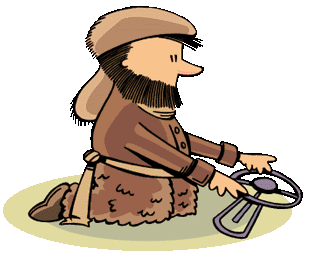American Mountain Men and the Western Fur Trade: Background
Updated: August 4, 2020

When Major S.H. Long first visited the Rockies during the Yellowstone Expedition of 1819, he found that the entire West, from Mexico to Canada, "...is almost wholly unfit for cultivation and of course uninhabitable by a people depending on agriculture for their subsistence..."
Today we can see that his assessment wasn't quite right. Thousands of families have worked farms and raised livestock throughout the northern Rockies. Long's comments would keep farmers and stockmen out of the region for years, but many men were already living and hunting in the Northwest; men who didn't rely on agriculture for their subsistence; men who lived from the native fruits of the land. In those days, artificial boundaries such as State or Territorial lines did not exist in the West, although the Convention of 1818 had recognized a U.S. border with Canada. Much of the area that eventually became Montana was part of Thomas Jefferson's Louisiana Purchase from the French; first explored by Lewis and Clark during their expedition of 1803 to 1804 Great Britain ceded us the rest.
Montana was arguably the richest fur country in North America during the 1820's and 30's. Historically, Indians in the area did not hunt many fur-bearing animals. Lynx and muskrat weren't considered good eating nor were their furs very useful for clothing. Bear and beaver were thought to have supernatural characteristics and so Indians refrained from killing them, though an occasional beaver was caught in a crude trap. Deer, elk, and moose all provided tastier meat and were better suited for use as clothing, moccasins, or tipis. Deer and elk were often caught in dead falls. Healthy animals were rarely killed. In fact, before the arrival of the horse in Indian country, around 1750, the only animal to suffer any real loss at Indian hands was the buffalo. Buffalo were herded over a pishkin (a cliff) or into a U-shaped valley. These were the famous buffalo jumps . Small tribes couldn't very well tell the buffalo to stop running over cliffs once hunters thought that they had jumped enough to feed tribal members. Still, the numbers of buffalo taken by Indians were nothing when compared to the vast herds, some estimate thirty million buffalo, running free on the plains.

During the early 19th century there still was not much of a textile industry in Europe or North America. Silks and cotton were scarce and expensive. Wool came only in dull colors. For ceremonial occasions it might be colored with indigo, a blue flower-based dye or else with cochineal, which is a crimson color produced by grinding a type of small bug and mixing it as dye. Either way, wool was coarse and uncomfortable.
Since the 1600's, fur had been popular in Europe. It was rich in color, it was warm, and most of all, it was comfortable to wear. In addition, leather was hard to come by in Europe. Most people wore some type of wooden clog or else wrapped rags around their feet. Only the rich might own a pair of leather shoes. The discovery of furred animals in North America raised the standard of living in Europe. Beaver hats or "high hats" became a status symbol for the rich. The higher the hat a man wore, the higher his social class (at least that was the idea then). The French and English battled for control of the fur trade in North America until the French were finally defeated in 1763. The English retained their dominance in the area even after the Revolutionary War, but America would eventually wrest control of the territory from British influence.
When President Jefferson commissioned Lewis and Clark's Corps of Discovery , he hoped that the fur trade might open the West to American settlement. He was right. Manuel Lisa built the first fur trading post in Montana on the confluence of the Bighorn and Yellowstone Rivers in 1807; just three years after Lewis and Clark completed their journey. Lisa's Fort began a tradition that would lead to the exploration and understanding of the West, especially Montana. At the time Lisa built his fort, three rival fur trading companies were already established. A German immigrant named John Jacob Astor owned the Pacific Company. The North West Company was run by the Scottish and worked by Frenchmen. Finally, the well-known Hudson's Bay Company represented British interests. Lisa's own company was named the Missouri Fur Company. In 1812 the Territory of Louisiana was renamed the Missouri Territory. These companies soon learned that the Indians knew of "beavers in our rivers as numerous as buffalo on the plains."

David Thompson, a Canadian working for the North West Co. established the second fur trading post in Montana along the Kootenai River in 1807 to 1809 . The Kootenai House post stood just north of what is now Libby in the northwest corner of the state. The North West Co. bought out the Pacific Co. in 1812.
Though individual trappers and traders rarely got rich from their endeavors, the large companies made quite a profit. Congress wanted to keep these profits in American hands. In 1816 Congress passed a law forbidding foreigners to trade furs on U.S. soil. But they did allow American citizens to employ the service of foreigners. Industry leaders believed there to be enough fur in just a few areas to occupy at least 100 trappers for a quarter century. The North West and Hudson's Bay companies merged in 1821 and began to enlist hunting parties to trap and trade for them. In less than twenty years the entire fur trade was all but over.
Updated: August 4, 2020

